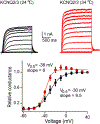Flexible Stoichiometry: Implications for KCNQ2- and KCNQ3-Associated Neurodevelopmental Disorders
- PMID: 33794528
- PMCID: PMC8440324
- DOI: 10.1159/000515495
Flexible Stoichiometry: Implications for KCNQ2- and KCNQ3-Associated Neurodevelopmental Disorders
Abstract
KCNQ2 and KCNQ3 pathogenic channel variants have been associated with a spectrum of developmentally regulated diseases that vary in age of onset, severity, and whether it is transient (i.e., benign familial neonatal seizures) or long-lasting (i.e., developmental and epileptic encephalopathy). KCNQ2 and KCNQ3 channels have also emerged as a target for novel antiepileptic drugs as their activation could reduce epileptic activity. Consequently, a great effort has taken place over the last 2 decades to understand the mechanisms that control the assembly, gating, and modulation of KCNQ2 and KCNQ3 channels. The current view that KCNQ2 and KCNQ3 channels assemble as heteromeric channels (KCNQ2/3) forms the basis of our understanding of KCNQ2 and KCNQ3 channelopathies and drug design. Here, we review the evidence that supports the formation of KCNQ2/3 heteromers in neurons. We also highlight functional and transcriptomic studies that suggest channel composition might not be necessarily fixed in the nervous system, but rather is dynamic and flexible, allowing some neurons to express KCNQ2 and KCNQ3 homomers. We propose that to fully understand KCNQ2 and KCNQ3 channelopathies, we need to adopt a more flexible view of KCNQ2 and KCNQ3 channel stoichiometry, which might differ across development, brain regions, cell types, and disease states.
Keywords: Autism; Epilepsy; KCNQ2; KCNQ3; Potassium channels.
© 2021 S. Karger AG, Basel.
Conflict of interest statement
Statement of Ethics
The authors have no ethical conflicts to disclose.
Disclosure Statement
The authors have no conflicts of interest to declare.
Figures


References
-
- Heyne HO, Artomov M, Battke F, Bianchini C, Smith DR, Liebmann N, et al.Targeted gene sequencing in 6994 individuals with neurodevelopmental disorder with epilepsy. Genet Med. 2019November;21(11):2496–503. - PubMed
-
- Moyses-Oliveira M, Yadav R, Erdin S, Talkowski ME. New gene discoveries highlight functional convergence in autism and related neurodevelopmental disorders. Curr Opin Genet Dev. 2020. Dec;65:195–206. - PubMed
-
- Jentsch TJ. Neuronal KCNQ potassium channels: physiology and role in disease. Nat Rev Neurosci. 2000. Oct;1(1):21–30. - PubMed
-
- Weckhuysen S, Mandelstam S, Suls A, Audenaert D, Deconinck T, Claes LR, et al.KCNQ2 encephalopathy: emerging phenotype of a neonatal epileptic encephalopathy. Ann Neurol. 2012January;71(1):15–25. - PubMed
Publication types
MeSH terms
Substances
Grants and funding
LinkOut - more resources
Full Text Sources
Other Literature Sources
Medical

